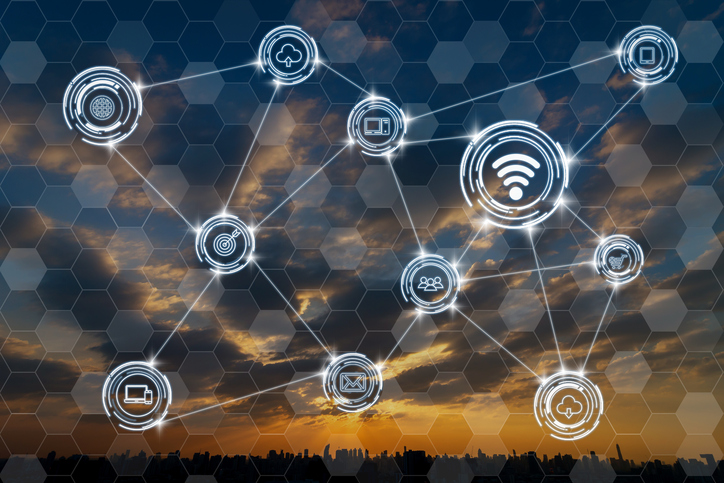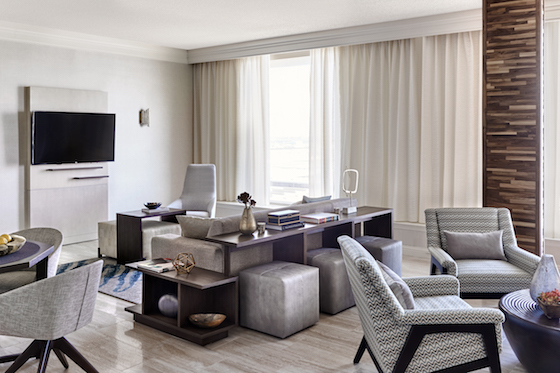Is there a more confusing term for hoteliers than Internet of Things? Yet increasingly, it’s a technology component that can help hotels improve both guest experiences and back of the house operations.
The Internet of Things – IoT – refers to a network of devices that can connect with each other and share information with each other. Hospitality technology consultant Ron Hardin suggests not thinking of it as a “thing.” “The Internet of Things isn’t a [single] thing,” he said. “It just refers to the fact that more devices have network connectivity built into them, whether that is a thermostat, door lock, TV or light fixture – you name it. Primarily, these things, or devices, can now be connected to a network and monitored and managed.”

Chances are, you’ve probably encountered this network of technology in a hotel room already, often in the form of a bedside tablet or a mobile app that can control the blinds, lights, thermostat and other room functions.
As the technology in each in-room device has become smarter, they have been able to connect with more devices and share more information. Hotels also have better tools for managing and monitoring all that information, from which they can make smarter business decisions, not just about the guest room but also the guest.
Hilton Worldwide and Marriott International are already focused on putting IoT in all their future guestrooms. Last year, Hilton unveiled its Connected Room, which is powered by IoT and which allows guests to control their room entirely from the Hilton Honors app and upload their own content to the in-room TV.
Marriott’s IoT Guestroom Lab shows how IoT can be used in both new-build and existing hotel rooms, including the function of voice control. Some of these features are standard room controls but Marriott is experimenting with smart mirrors, mood lighting and even digital art selection.
What’s the future?
Impressive technology aside, the benefits of IoT for all hotels, big or small, branded or not, are clear.
“The more connected systems we have in a building,” said Bill Lally, president of New York-based Mode: Green, a hospitality technology integration firm, “the more intelligently we can run that building.”
For example, Lally said, door locks can trigger lights and thermostats, shutting down when guests leave the room. When a guest re-enters, their preferred lighting and temperature levels can go back to exactly where they were before. In an IoT-connected hotel, engineers can also have tools that can show which HVAC units aren’t heating or cooling correctly and can add that to a maintenance list before a guest finds out (and sends in a complaint.)
At the newly renovated Los Angeles Airport Marriott, the HVAC system is cloud-based, allowing anyone with access to the website to change the temperature in the guest rooms instantly. The building’s outside lighting also is controlled through the cloud.
These connected systems can monitor energy usage in each room, allowing hotels to see where they are wasting energy and why. For hotels looking to up their sustainability game, IoT is a clear choice: Lally said his company sees on average of 30% energy savings in hotels with connected systems.
Operational efficiencies improve with IoT as well, Lally added. With electronic Do Not Disturb signs, housekeeping can better monitor which rooms can be cleaned or not before a housekeeper starts making the rounds on the floor. “From a resource standpoint and a serviceability standpoint, the operational efficiencies of these types of systems are huge,” he said.
Yet there is a cost involved, at least upfront. Hospitality consultant Hardin said the cost of building an IoT system can be a drawback for hotels because it’s not just about putting in a super-fast wireless network.
“This is where you reallly have to understand that IoT isn’t a thing,” he said. “It’s made up of other things” such as tablets, smart thermostats, sensors, voice assistants and the like, all of which a hotel needs to buy.
The good news, he said, is that the devices are getting cheaper and more accessible. And hoteliers understand that technology is the way forward to an improved guest engagement and experience.

“It’s not going to be too far down the road where the touchpoint for the guest is a combo of tablet, phone and touchscreen,” he said.
Security concerns
However, one thing hotels should not skimp on when deploying IoT is network security, Hardin said, and they should do it upfront.
“Security has to be top of your list whenever you expand scope of your network and put devices on it,” he said. “Whether investing in a guest engagement product or an energy management product, or even back of house product, security has to be factored into the decision, selection, and design and built in upfront.”
Privacy concerns on the guests’ part is also important for hotels to think about, especially since many guests might believe a smart device like the Alexa is spying on them. Lally said these devices are not listening in on guests, and hotels are actually adding them because they are finding that their guests already have similar devices in their homes and want their hotel stay to be on par with their home experience. But he agreed not all guests will want this.
“People are still afraid of technology in a lot of ways. Creating a solution that appeals to all demographics is one of our biggest challenges,” he explained. “Not just by age group, but by who’s comfortable with technology and who’s not. Redundancy is hugely important in our designs. We always make sure that there’s more than one way to do something in a room.”
